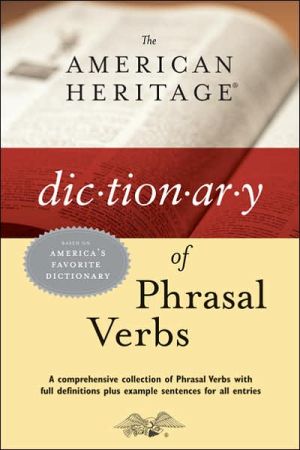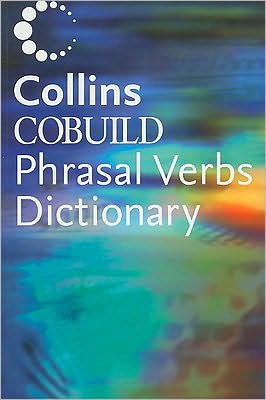The American Heritage Dictionary of Phrasal Verbs
The ability to understand and use phrasal verbs—verbs that are followed by one or more particles, acting as a complete lexical unit—is essential to the full comprehension of English. The American Heritage® Dictionary of Phrasal Verbs lists and defines thousands of phrasal verbs, such as look up as used in the sentence “She looked up the word in the dictionary.” Extremely useful to both learners of English as a second language and native speakers of English, this completely new reference work...
Search in google:
The ability to understand and use phrasal verbs—verbs that are followed by one or more particles, acting as a complete lexical unit—is essential to the full comprehension of English. The American Heritage® Dictionary of Phrasal Verbs lists and defines thousands of phrasal verbs, such as look up as used in the sentence “She looked up the word in the dictionary.” Extremely useful to both learners of English as a second language and native speakers of English, this completely new reference work draws on the authority of The American Heritage® Dictionary of the English Language, Fourth Edition, while incorporating new material for thorough, up-to-date coverage of phrasal verbs. Each fully defined phrasal verb is entered in an A–Z format and is followed by helpful example sentences that place the verb in context and show how the verb fits into the sentence structure. For example, at button up, meaning “to fasten all the buttons on a garment,” full sample sentences illustrate two acceptable constructions, “button the sweater up” and “button up the sweater.” Grammatical information is conveyed by straightforward examples instead of confusing codes and abbreviations. The principal conjugations and pronunciations of each verb are included, and all information is presented in a clear, contemporary, and accessible format, a hallmark of the American Heritage® Dictionaries. Library Journal This dictionary focuses on phrasal verbs, specifically those that have meaning beyond the literal definitions of the words involved. Organized alphabetically, it offers clearly written, brief definitions with sample sentences. For example, eight definitions are given for "Come Up." Six pages list numerous phrasal verbs starting with "Come," ranging from "Come About" to "Come with." Definitions show attention to detail, such as listing the use of the phrase come about specific to sailing (to change direction). Likewise, the following features will appeal to English-language learners: an uncrowded, two-column page layout, easy-to-read type, and a pronunciation key on all odd-numbered pages. A few weaknesses should be noted, however: there is no glossary of linguistic terms that are occasionally used, e.g., intransitive verb, and cross references between definitions are minimal. In contrast, a lengthy Phrase-Finder Index is a key element of McGraw-Hill's Dictionary of American Idioms and Phrasal Verbs, as are brief definitions and sample sentences. Yet the inclusion of idioms allows a phrase such as "Look me up while you're in town" to be alphabetized under "look me up..." instead of under the verb "look up," as in this work. The large index guides readers to the right entry. Bottom Line With more than 24,000 entries, the McGraw-Hill resource is a more comprehensive, more complex, albeit slightly more expensive resource. Still, this work's straightforwardness and accessibility highly recommend it to English-language learner collections in large libraries.-Marianne Orme, Des Plaines P.L., IL Copyright 2005 Reed Business Information.
Editorial & Production StaffivGuide to the Dictionary of Phrasal VerbsvPronunciation KeyxiiDictionary of Phrasal Verbs1
\ Library JournalThis dictionary focuses on phrasal verbs, specifically those that have meaning beyond the literal definitions of the words involved. Organized alphabetically, it offers clearly written, brief definitions with sample sentences. For example, eight definitions are given for "Come Up." Six pages list numerous phrasal verbs starting with "Come," ranging from "Come About" to "Come with." Definitions show attention to detail, such as listing the use of the phrase come about specific to sailing (to change direction). Likewise, the following features will appeal to English-language learners: an uncrowded, two-column page layout, easy-to-read type, and a pronunciation key on all odd-numbered pages. A few weaknesses should be noted, however: there is no glossary of linguistic terms that are occasionally used, e.g., intransitive verb, and cross references between definitions are minimal. In contrast, a lengthy Phrase-Finder Index is a key element of McGraw-Hill's Dictionary of American Idioms and Phrasal Verbs, as are brief definitions and sample sentences. Yet the inclusion of idioms allows a phrase such as "Look me up while you're in town" to be alphabetized under "look me up..." instead of under the verb "look up," as in this work. The large index guides readers to the right entry. Bottom Line With more than 24,000 entries, the McGraw-Hill resource is a more comprehensive, more complex, albeit slightly more expensive resource. Still, this work's straightforwardness and accessibility highly recommend it to English-language learner collections in large libraries.-Marianne Orme, Des Plaines P.L., IL Copyright 2005 Reed Business Information.\ \

